“Was ist loos? Der Hund is loose.” Stroszek (Werner Herzog, 1977)
Sep
9
German Language Day

A warm Railroad Flats, Wis. “Willcomen” [sic] for (LtR) Scheitz, Eva, and Bruno, with Mr Scheitz's nephew (Clayton Szalpinski) squeezed between his “Onkellein” and Eva. DP: Thomas Mauch.
Bruno Stroszek (Bruno S.), his friends Eva (Eva Mattes) and Scheitz (Clemens Scheitz, responsible for the fairy-tale music you hear in this film) decide to leave dreary #Berlin behind and move to #Wisconsin where the latter's nephew lives. A new life, with dreams of music and animal magnetism, awaits them there.
– Clayton
As so oft with #Herzog, the story behind Stroszek is as engrossing as the resulting film. Documentary maker Errol Morris and Herzog were fascinated by Wisconsin's own Ed Gein and wondered if Gein had dug up his own mother, as was rumoured at the time. As they would, they decided to open the poor woman's grave. Morris never showed up, and neither did Herzog but only because his car broke down en route to Plainfield, Wisconsin. Trying to get the vehicle fixed, Herzog entered the workshop of a Clayton Szalpinski.
A character in his own right, and a non-actor to boot, Clayton ended up in Stroszek as Scheitz's nephew; a MacGuffin odder than a dancing chicken.
comedy
“We're in America now.”Stroszek (Werner Herzog, 1977)
Sep
9
turkey
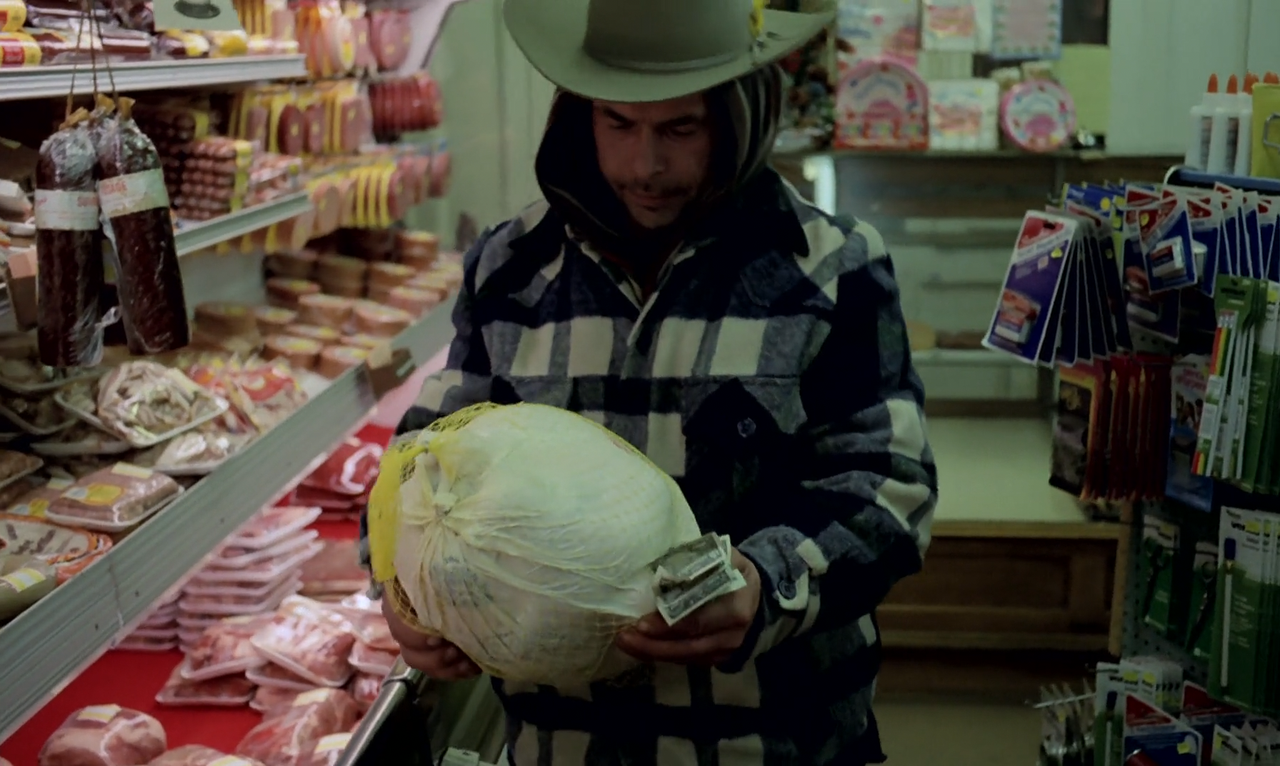
Bruno (Bruno S.) shopping in a small American convenience store. He's holding a wad of dollar bills and a huge bird that he just took out of a very opulently stocked cooler. DP: Thomas Mauch.
– Bruno S.
ねこぢる草 [Nekojiru-sō / Cat Soup] (Tatsuo Satō, 2001)
Aug
30
National Grief Awareness Day
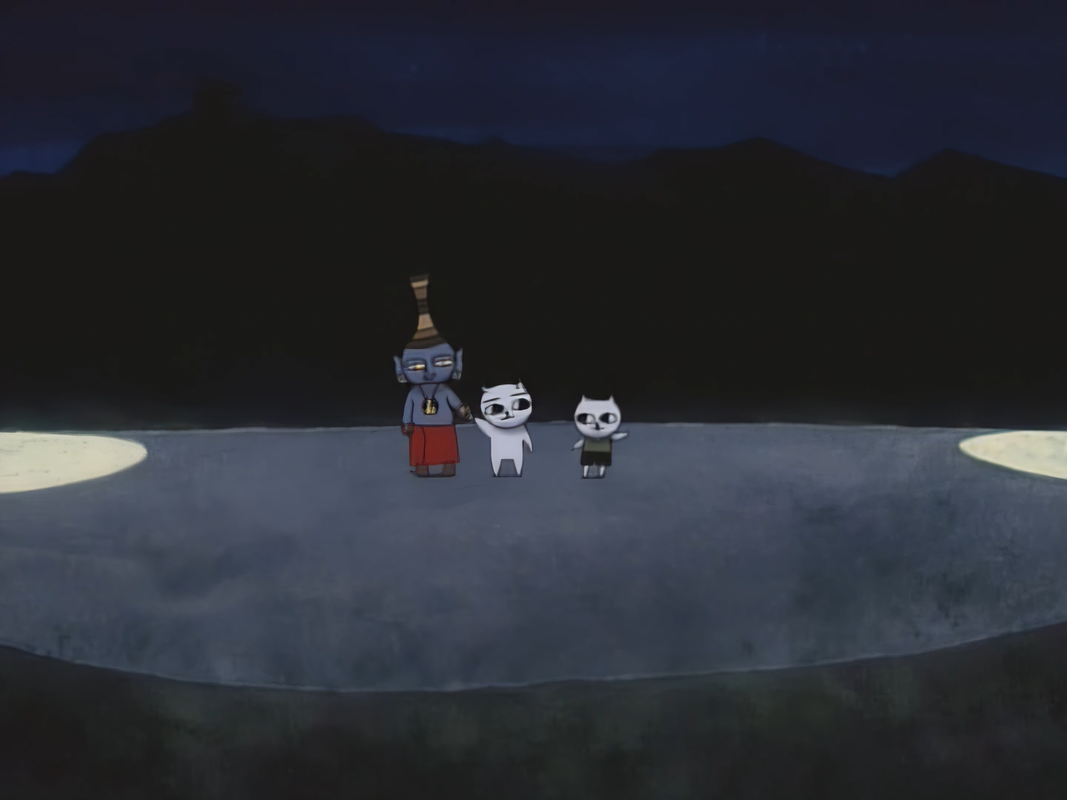
Nyāko taken away by Jizō with little brother Nyatta telling Nyāko to come back home. DP: Masaru Takase.
Nyatta is not ready to have Jizō take away his big sister Nyāko to Ne-no-kuni, the land of the dead. The kitten grabs his sister's paw, resulting in her soul being ripped in two and leaving Nyāko in a state of limbo. The cats' mother then sends the two off on a mission to buy fried #tofu. Maybe now Nyatta can find a way to put Nyāko's divided soul back together. But first, there's a circus to visit!
ねこぢる草 is based on works by mangaka Nekojiru / ねこぢる (1967—1998) whose trademark crudely drawn #cats caused a ripple in Japan's underground #manga circuit. Nyatta and Nyāko continued their surreal adventures by way of widower Yamano Hajime after Nekojiru's tragic suicide in 1998.
Vražda ing. Čerta [The Murder of Mr. Devil / Killing the Devil] (Ester Krumbachová, 1970)
Aug
18
Serendipity Day

Ona (Jiřina Bohdalová) is her wonderful kitchen, smoking two well-deserved cigars. DP: Jiří Macák.
Ester Krumbachová's feminist farce is a delight of many flavours. Ona (Jiřina Bohdalová) is already 40 and in need of a man. She remembers one from her youth, the handsome, slim, and very cultured Eng. Bohouš Čerta (litt. “God the Devil, Engineer”, played by the always great Vladimír Menšík), and knows that the one way to a man's heart is through the stomach.
Her cooking is immaculate. So are her looks and her apartment (all created by one-time director Krumbachová who worked as a costume designer and screenwriter). Unfortunately, her beau has turned boorish and stuffs his face with all but her and the furniture (is that true?). But cooking she can, and wanting she does. So she cooks and cooks and cooks up some more.
Sedmi kontinent [Sedmý kontinent / The Seventh Continent] (Dušan Vukotić, 1966)
Aug
12
teevee dinner
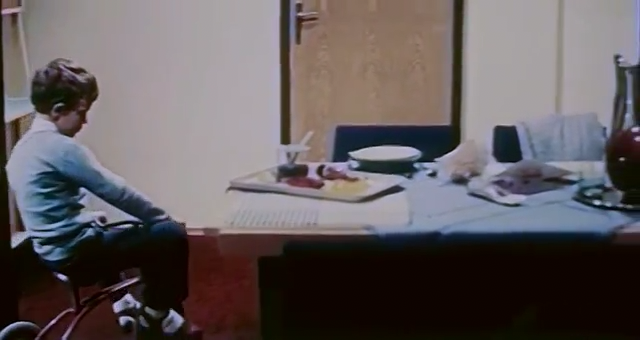
A little blond boy on a red tricycle driving past his TV-ish dinner in an empty house. DP: Karol Krška.
His Wife's Mistakes (Roscoe Arbuckle, 1916)
Aug
4
National Water Balloon Day

Janitor Roscoe uses the comedy staple seltzer bottle to fill a balloon with some spritz!
The great Roscoe Arbuckle just can't help himself at the wonderfully hedonistic Oriental Café in this delightful short slapstick.
“Ah, well, if you love somebody, shoot!”La ragazza con la pistola [The Girl with a Pistol] (Mario Monicelli, 1968)
Jul
28

Assunta Patanè (Monica Vitti) seated between two dinner tables on a long, padded bench. She's clutching her purse and appears to be waiting for something. On the table to her right a sugar bowl and a branded ashtray. DP: Carlo Di Palma.
– Dr. Tom Osborne
Swirlee (James Lorinz, 1989)
Jul
23
National Vanilla Ice Cream Day
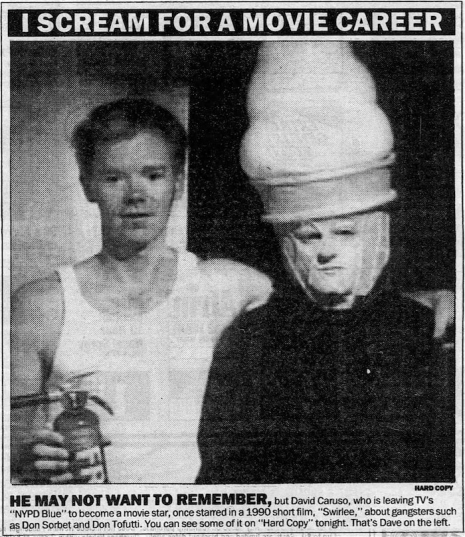
Newspaper clipping. Mr Softy's roommate (David Caruso) and Mr Softy (James Lorinz), a man with a softee for/as a head, pose for a picture.
“The boys come to soak up the sun, and a few carloads of beer. The girls come, very simply, because this is where the boys are.”Where the Boys Are (Henry Levin, 1960)
Jul
21
Legal Drinking Age Day

While chatting up TV Thompson (Jim Hutton), Tuggle Carpenter (Paula Prentiss) presents a fake ID to prove that with her “25” years of age she's old enough to drink. The ID also states that despite her 5'10” (1,78m) frame, she's a petite 5'2” (1,57m). DP: Robert J. Bronner.
Where the Boys Are is chock-full of characters whose names appear to be straight space-travel-lifted from various #JohnWaters' movies: Tuggle Carpenter! TV Thompson! Lola Fandango! Dr. Raunch for Chrissakes!
– narrator
We follow four female midwestern college students on #SpringBreak in Fort Lauderdale. Their objective is boys boys boys (and an even tan) and nothing, including being too young to drink, can stop them. This was one of the first post-Hayes Hollywood movies to address teenage sex yet despite all the innuendo (“What's your shoe size?” “13.” “Get in the car!”), it's all pretty clean. But without these girls, there wouldn't be any Dawn Davenport. And that would've ruined everybody's Christmas.
“Today is our Queen's wedding day, let us drink it up!”盘丝洞 [Pan si dong / The Cave of the Silken Web] (Dan Duyu, 1927)
Jul
14
Pandemonium Day
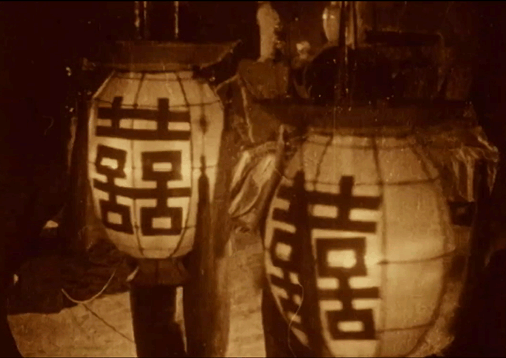
Pandemonium happening, with Tang Sanzang as its object of desire (gif via. DP: Ganting Dan.
Dan Duyu's 盘丝洞 is, in its most literal sense, a fantastic silent interpretation of Wu Cheng'en's 西遊記 / Journey to the West. Monk Tang Sanzang (Meikang Jiang) finds himself trapped in a cave with seven beautiful sisters. Two of Tang Sanzang's faithful disciples, Sun Wukong (the Monkey King) and Zhu Bajie (Pigsy: half man, half pig), need to save him before one of the sisters takes the celibate monk as her husband. What follows is a vigorous display of #wuxia, horror, monkey shenanigans, and – during the pandemonium unfolding in the final act – a small glimpse into the vast pantheon of China's gods and demons.
Note that some of the reels are still missing, and the English translation I found is subjective at best, so have a translation app at the ready. Nevertheless, take a moment to dim the lights, and accompany Tang Sanzang, the Monkey King, and Pigsy on their pilgrimage. Even if only for a little while.